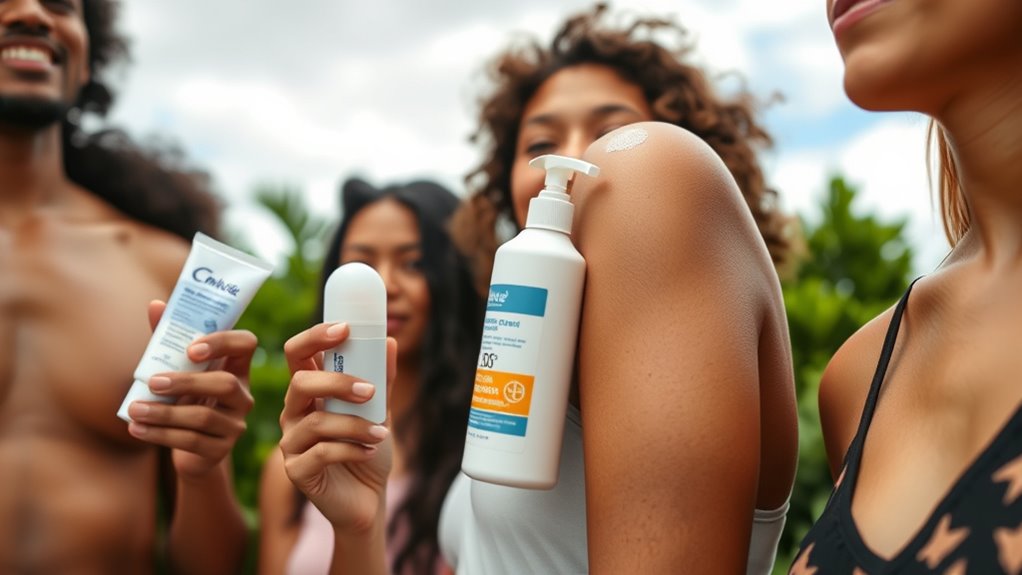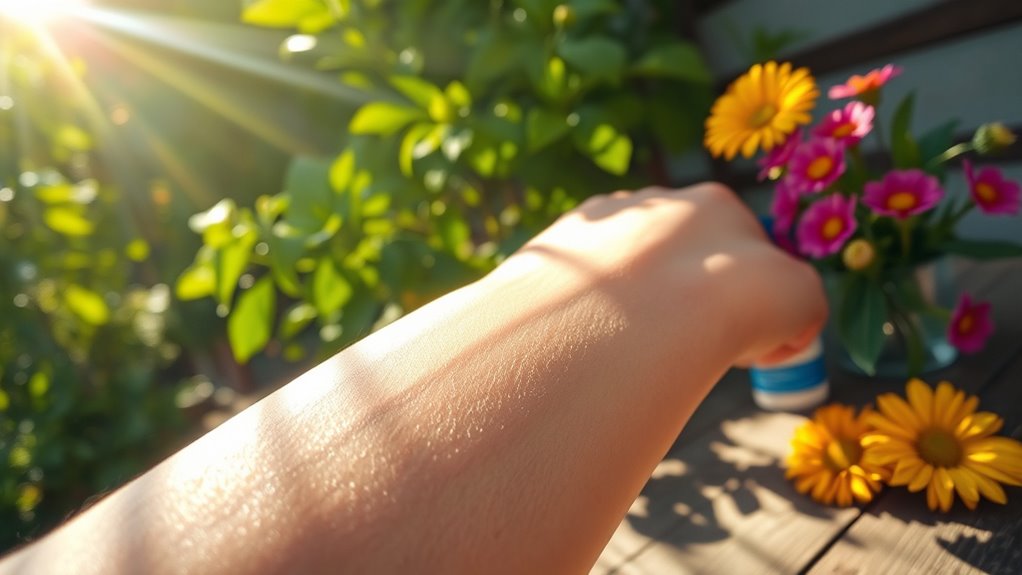Sunscreen isn’t just for summer; it’s essential year-round to protect your skin from harmful UV rays. UV rays can penetrate clouds and windows, causing long-term damage like aging, dark spots, and even skin cancer. Make applying broad-spectrum sunscreen a daily habit, covering all exposed areas and reapplying every two hours or after sweating. Staying consistent lowers risks, and if you want to learn how to maximize your protection daily, keep exploring this guide.
Key Takeaways
- Sunscreen should be used daily, regardless of the season or weather conditions.
- UV rays can penetrate clouds and windows, making year-round protection essential.
- SPF 30 or higher blocks most UVB rays; reapplying every two hours maintains protection.
- Proper application includes generous coverage on all exposed skin, including ears, neck, and feet.
- Consistent daily use of sunscreen prevents skin aging, dark spots, and reduces skin cancer risk.

Have you ever wondered why sunscreen is essential for your daily routine? The truth is, protecting your skin from the sun’s harmful rays isn’t just a summer concern; it’s a year-round necessity. Whether you’re heading outdoors for a quick walk, running errands, or commuting to work, UV rays can penetrate your skin and cause damage even on cloudy days. Following proper SPF guidelines can help you minimize the risk of skin damage, which can lead to premature aging, dark spots, or even skin cancer. It’s important to understand that SPF, or Sun Protection Factor, isn’t just a number on a bottle—it’s a critical part of your defense against the sun’s harmful effects. An SPF 30, for instance, blocks about 97% of UVB rays, but no sunscreen can block 100%. That’s why applying enough product and reapplying regularly is vital.
Your skin is constantly exposed to UV radiation, and over time, this exposure accumulates, leading to irreversible skin damage. Even if it’s overcast or you’re indoors near windows, UV rays can still reach your skin, contributing to long-term harm. That’s why adhering to SPF guidelines isn’t just about choosing the right sunscreen; it’s about applying it correctly and consistently. Experts recommend using broad-spectrum sunscreens that protect against both UVA and UVB rays, as both types can contribute to skin damage. Don’t skimp on the amount—most people don’t apply enough, which considerably reduces the effectiveness of your sunscreen. A generous layer should be applied to all exposed skin, and don’t forget areas like your ears, neck, and the tops of your feet.
Reapplication is equally essential, especially if you’re spending extended time outdoors. Reapply every two hours or immediately after sweating or swimming. Remember, sunscreen isn’t just for beach days or outdoor sports; it should be part of your daily skincare routine. Incorporate it into your morning routine, just like brushing your teeth, and make it a habit. Protecting your skin from sun damage isn’t complicated, but it does require consistency and awareness of SPF guidelines. Additionally, using proper application techniques can significantly enhance the effectiveness of your sunscreen. By doing so, you’re not only preventing immediate discomfort like sunburn but also safeguarding your skin’s health for years to come. Ultimately, taking these simple steps guarantees you enjoy sunny days without compromising your skin’s health or appearance.
Frequently Asked Questions
How Often Should I Reapply Sunscreen During Cloudy Days?
On cloudy days, you should still reapply sunscreen regularly. Clouds don’t block all UV rays, so your skin remains exposed. It’s best to reapply every two hours, especially if you’re outdoors or sweating. Remember, sunscreen reapplication is key to protection, even when the sun isn’t visible. Don’t skip this step—your skin needs consistent defense against UV damage, no matter the weather.
Can Sunscreen Cause Skin Allergies or Irritation?
You might wonder if sunscreen can cause allergies or irritation. If you have ingredient sensitivities, certain components like fragrances or preservatives could trigger allergy symptoms or skin irritation. Always check labels for potential irritants and do a patch test before full application. If you notice redness, itching, or swelling after using sunscreen, stop using it and consult a dermatologist to identify the cause and find suitable products for your skin.
Is Mineral or Chemical Sunscreen Better for Sensitive Skin?
When choosing between mineral and chemical sunscreen for sensitive skin, mineral sunscreens typically win because they’re more compatible. They contain zinc oxide or titanium dioxide, which sit on your skin and reflect UV rays, reducing irritation. Chemical sunscreens absorb UV light but may cause reactions in sensitive skin. If you want a gentle option, go for mineral formulas; they’re usually better suited to avoid irritation and allergies.
How Does Sunscreen Affect Vitamin D Production?
Did you know that just 10-15 minutes of UV exposure can produce enough vitamin D for most people? Sunscreen can slightly reduce vitamin D synthesis because it blocks UV rays needed for production. However, you still get some benefits, and short, safe sun exposure combined with sunscreen use helps balance vitamin D levels and skin protection. Always be mindful of your skin type and local UV index to optimize both.
Can Sunscreen Be Used on Children Under Six Months?
You should avoid using sunscreen on infants under six months old. Instead, prioritize infant sun protection by keeping your baby in the shade, dressing them in protective clothing, and using hats. Sunscreen alternatives like clothing and umbrellas are safer options for young babies. If sun exposure can’t be avoided, consult your pediatrician for guidance, but generally, it’s best to limit direct sun exposure for infants under six months.
Conclusion
Remember, sunscreen isn’t just a summer fling—it’s your year-round skin shield. Think of it as a loyal guardian that stands watch through every season’s changing face. By making sunscreen a daily habit, you’re planting seeds for healthier skin that will flourish over time. Don’t wait for the sun to storm; protect your skin now and enjoy the long-term glow that’s worth every effort. Your skin’s future self will thank you for this unwavering act of self-care.









